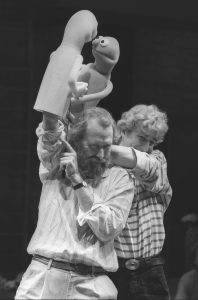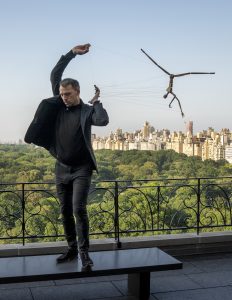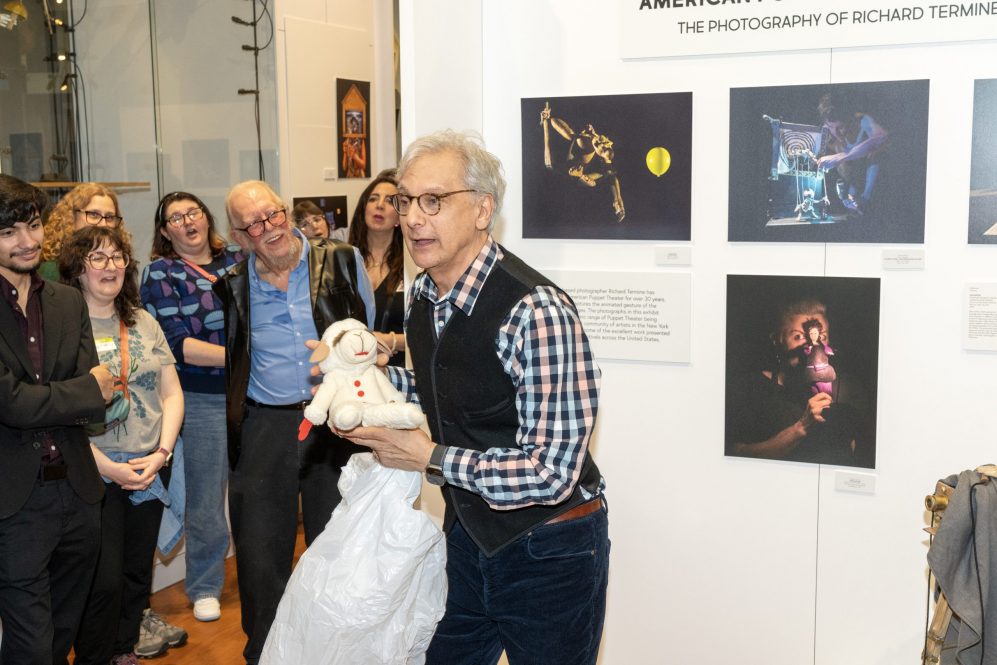The lens of Richard Termine’s camera frames the performers before him like the decorative proscenium around a stage, in a view the award-winning photographer says is both wonderful and challenging to capture.
Termine says he considers himself a partner to the performers, moving in a dance around them, anticipating their next move, as he clicks his way to capturing the moments of life and emotion they convey.
A Middletown native and double UConn alum, he started studying the dramatic arts as an elementary student who went to the library to learn more after seeing a marionette performance of “Rigoletto,” he says.
“It just blew me away. It was transformative,” Termine ’75 (SFA), ’78 MFA says of that school assembly. “When I go to the theater … I want to go to worlds and places I haven’t been, and puppetry is No. 1 on the list that does that for me.”

A one-time puppet designer, puppet builder, and puppet director, Termine lists name-brand shows on his resume including “Sesame Street” and readily talks about knowing the famed duo Jim Henson and Frank Oz. He discovered photography in the late 1970s at the suggestion of a friend.
Today, he lists the New York Times and Village Voice, along with Time, Newsweek, and People among his credits. Yet, even after decades in the business, Termine says he still marvels at the power of puppets and their performers.
“I’m standing on their shoulders in terms of my art form, and I’m the interpreter of what’s in front of me,” he says. “What I love about this is I’m transformed when I’m working. … When I’m in the moment, it’s exhilarating.”
Visitors to the Ballard Institute and Museum of Puppetry will have a chance to see just what Termine sees when he puts his eye to the camera. Its latest exhibition, “American Puppet Theater Today: The Photography of Richard Termine,” includes 151 of his images.
The show, courtesy of The Jim Henson Foundation, was created in 2019 for display in France and since has seen five iterations including at exhibitions in Chicago, New York City, Montreal, and College Park, Maryland. Its Connecticut show in Storrs is on display until May 11.
From Marionette and Shadow to Rod and Hand
Foundation President Cheryl Henson, curator of the exhibition and daughter of renowned puppeteer Jim Henson, uses words like “play, magic, imagination, and creativity” when talking about the importance of puppetry and its value in the world today.
“Puppetry brings out all of these really essential parts of being human,” she says.
While the Muppet style her father made famous on shows like “Sesame Street” might have the broadest reach of any style – the show featuring Big Bird, Oscar the Grouch, and Elmo has aired in 124 countries – she says the accessibility of the myriad puppet styles is what gives puppetry “infinite potential.”
Much of that variety can be seen in “American Puppet Theater,” with Henson describing the show as “a celebration of what puppetry can do.”
During a recent tour of the exhibition, Termine points out a 2011 photograph of Jim Rose, a marionette fabrication teaching artist, and says it’s among his favorites. The image is simple: a puppeteer fiddling with the cross brace of a marionette, tugging at a string that lifts the puppet’s head in a loving gaze toward its handler.
Henson notes that thanks to UConn’s John Bell, director of the Ballard, and Emily Wicks, the museum’s operations and collections manager, the exhibition has 15 puppets on display alongside Termine’s photographs.
She walks toward the first, which greets those entering the exhibition, a direct-manipulation puppet named Disfarmer – a small bald man with glasses – adjusting the back of a Depression-era camera draped in a dark cloth. It’s one of six versions made for a 2009 production about photographer Mike Disfarmer.
Another puppet, this one with a political message, is poised in the back corner of the Ballard. It’s a toy theater with a black proscenium adorned with four ornate butterflies from the performing company Great Small Works. Next to it, Termine notes, is a 2010 photograph depicting a performing John Bell; his wife, Trudi Cohen; and Jenny Romaine.
The Blue Fairy from the opera “La Bella Dormente Nel Bosco” swoops through the air in the opposite corner, while a couple of Punch and Judy-style hand puppets get some laughs long after their 2009 adult-only performance of “The Punch and Jimmy Show.”
While the exhibition features mostly puppets outside the Muppet style, Termine says the show reflects the impact Jim Henson, who died in 1990, and his Foundation have had on the puppetry world.
Puppet Arts Program: A Diamond Year
The Jim Henson Foundation, founded by its namesake in 1982, is devoted to cultivating the work of American puppeteers and has provided support for more than 1,300 projects from more than 350 artists in that time.
“When we look at [this exhibition], these are artists that have been supported by the Foundation, creating their own work, finding their own voices in this rich art form,” Termine, Foundation vice president, says. “It’s right here, and that’s what makes this special.”

“One of the things my dad really loved about puppetry is how much the different puppeteers loved watching each other’s work and how they’d get so excited about somebody else’s brilliance,” Henson adds.
Say a name related to the puppet community and Termine and Henson can explain the loop of how that person is connected to this person and the next. It’s a community, they say, and many in it have UConn ties.
Termine’s mother once met Carol Thompson ’68 (SFA), ’78 MA, a student of renowned UConn professor Frank Ballard, who introduced Termine to the famed puppeteer in 1970 when he was doing a production of “The Love for Three Oranges” at UConn.
The friend who nudged Termine in the late 1970s to take up photography was the late Manchester-native-turned-Emmy-nominated puppet designer Jan (Rosenthal) Stefura ’77 (SFA), who built Mokey Fraggle on “Fraggle Rock,” among others.
Termine’s MFA class included Bart Roccoberton Jr. ’90 MFA, who heads UConn’s Puppet Arts Program, and his teachers included the late Jerry Rojo, the former dramatic arts professor who designed the black box Mobius Theater in the Drama/Music building.
With deep connections in the puppet world, UConn’s Puppet Arts Program celebrates its 60th anniversary this year with a special section of the exhibition dedicated to that achievement.
It’s “a leader” in the industry, Termine says, so much so that several years ago, when a couple of UConn women’s basketball players visited the set of “Sesame Street,” most of crew sported their UConn garb to share their school pride.
The same sense of delight swelled in Termine when he visited the Ballard Museum in Downtown Storrs recently for the exhibition’s opening: “To come back here and to share what I started,” he said, trailing off in thought. “Thanks to the Henson family and to my training here at UConn.”



